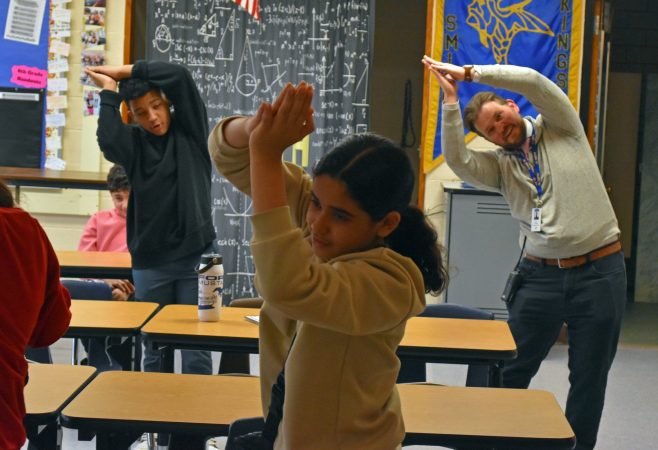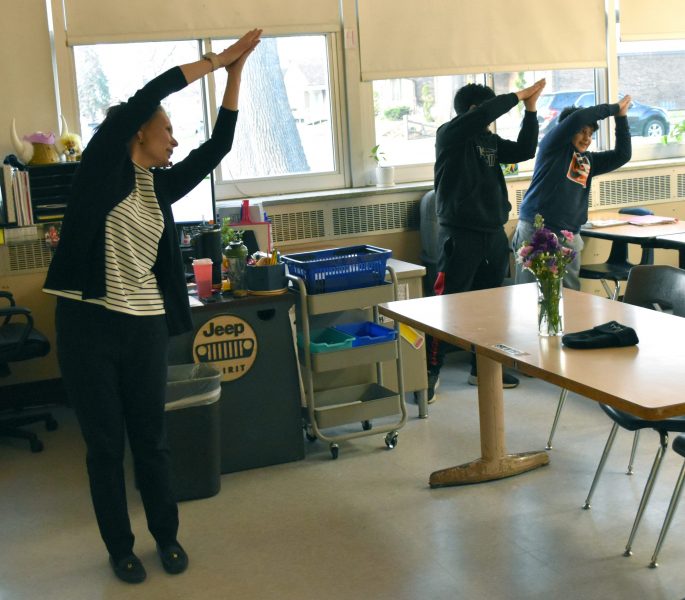Mindful of mindfulness, Smith Middle School students are starting their school days with some deep breathing, yoga stretches and rethinking their thinking.
The school this semester is piloting a program called Teens Work It Out, which is intended to help students develop better tools for dealing with stress and avoiding unnecessary anxiety from poor thinking, said Principal Mark Rummel.
“We’re trying to get kids reconnected after the pandemic. We hear about social-emotional learning, but really it’s just about getting reconnected in general,” Rummel said.
Teens Work It Out (TWIO) is being developed by Dr. Cheryl Somers and a team at Wayne State University’s Center for Health and Community Impact (CHCI). The yoga portion of the three-part TWIO program was inspired by Kids Work It Out, originally by Danialle Karmanos, and now run by the CHCI as well. But Kids Work It Out targets elementary school students and is mostly about breathing and stretches. Teens Work It Out adds a vital third component looking at thinking habits.
“It’s not just about getting their stress out through movement,” Somers said. As a school and counseling psychologist, she really wanted to help the older students be mindful of errors in their thought process that can be the cause of a lot of their stress.
“We talk with teens and tweens about how what they think can drive their feelings and then their actions. We talk about how when you realize that you can control your emotions more and avoid being overly emotional and over dramatic,” Somers said.
Lessons in TWIO remind students to be aware of common pitfalls in thinking. Are they always assuming a worst case scenario, which locks them in panic mode, instead of considering a more likely outcome? For example, maybe a friend not texting back is simply because their phone is dead or they are busy, not that the friend is mad.
Another lesson looks at the all-or-nothing type of thinking. “When something isn’t perfect, we see it as a failure; when something goes wrong, we may feel the whole day is ruined,” says the lesson guide. A more balanced approach can reduce anger and frustration, Somers points out.
“As kids get older, they start thinking and overthinking things more,” Somers said, talking about students “over catastrophizing.” Cognitive distortions – assuming you can’t do certain things, that things are worse than they are, or that situations are more unfair – feeds into the anxiety, depression and other issues that many youth struggle with.
Each of the 10 weeks of TWIO lessons include a new breathing exercise, a new yoga/stretching movement and a mindset lesson – the “mindful trio” as Somers calls them. Smith students spend a few minutes on the lessons during their advisory period at the beginning of the school day.
“Those things together are going to make kids more aware of themselves and in control and have more tools for self-regulation,” she said. Hopefully, the result will be less stressed students who are better able to focus and do well in school.
“The program is very well put together,” Principal Rummel said. “I think for the students that are into it, it is going well.”
“One of the biggest challenges we have is to get kids on board to do it,” he added.
Because the program is part of a study, students are not required to participate. About 40 percent of Smith Middle students are taking part of the lessons. Rummel and Somers both hope to find ways to improve that number.
“With middle schoolers, they always have trouble getting past the embarrassment part of it,” Somers said. The videos and materials are also accessible to parents so they can encourage practice at home or reinforce lessons by using some of the same terms.
As part of the pilot, participating students will fill out surveys about the program, which measure their attitudes and feelings on a number of dimensions such as self-esteem, connection to school, mood, and self-confidence. Somers will also look at indicators such as grades, attendance and behavior to try to measure the impact.
The hope is the lessons will help students both now and in the future.
“Adults could benefit from some of this material, too,” Somers noted.
Teacher Abeer Savage said she has been doing the exercises in class to encourage her students to participate.
“I like it. It actually even helps me as a teacher to deal with some of the stresses I have,” Savage said. “It helps me start my day better.”
Savage sees the difference in students who participate in the lesson.
“I do see some better calmness from students who are better able to respond to this,” Savage said.
She especially likes the mindset discussions and will pause the video to ask students if they have experienced something similar. Often students will share their experiences.
“Because there is so much on social media, students struggle with how to respond in certain situations,” Savage said. She recalled a lesson on “fortune telling,” which is assuming something will happen. She gave the example of a student who assumes a teacher won’t answer a question so doesn’t ask or is unsure what a friend meant by a comment but doesn’t seek clarification thinking the friend would get annoyed. In both cases, the student had the power to make the situation less stressful, but did not act because of faulty thinking.
TWIO is so beneficial, “because of all these students not knowing how to cope with these little stresses or big stresses at home or because of social media,” Savage said.
Rummel said, “It just seemed like there was so much upside to it, so why not? Why not try it and see if it helps.”
“The hope is that it’s an investment. Hopefully it will translate this year, but maybe even more down the road,” he said.


